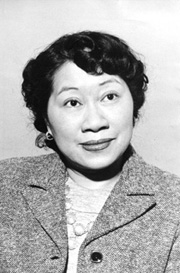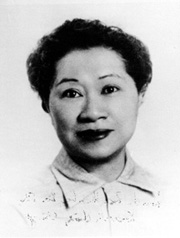Rose Hum Lee
By Dr. Henry Yu, University of California at Los Angeles
The following is excerpted from Dr. Yu’s book, Thinking Orientals: A History of Knowledge Created About and By Asian Americans (New York: Oxford: 2000):
Rose Hum Lee, author and lecturer, brings to her audiences outstanding charm and the thought-provoking impressions of her dual perspective, a product of two civilizations–the ancient tradition-steeped culture of China and the new, virile and uninhibited culture of America. Reared by Chinese parents in the classics and traditions of China, the surroundings of her early childhood were the rugged mountains of America’s Northwest.
So began a flyer advertising the lectures of Rose Hum Lee. She spoke to Rotary clubs, high schools, women’s clubs, anyone who was willing to listen and willing to pay her way. She was a popular speaker, and the flyer prominently displayed the rave reviews of groups ranging from the Women’s Club in White Fish Bay, Wisconsin, to the Argonauts Club in San Bernandino, California.
Lecture topics included Chinese art and symbolism, Chinese customs old and new, America as seen through Chinese eyes, America’s role in the Far East, Generalissimo Chiang Kai-Shek, the Chinese Nationalist Party (Guomindang) and of course, the Chinese in America. Typically, Rose Hum Lee would give her lectures in “perfectly fluent, flawless English,” and afterwards, dressed in the ‘traditional’ cheong sam (a long silk dress) of Chinese women, would sell assorted chinoiseries and bric-a-brac as souvenirs. And so Lee put herself through college, and made a lucrative living on the side while teaching.
Rose Hum Lee was born in Butte on August 20, 1904 to Hum Wah Long and Lin Fong. Her father operated a merchandise store in Butte’s China Alley at 102 South Main Street. She attended Garfield Elementary School, Washington Junior High and graduated from Butte High School.
After graduating from high school in 1921 and attending the local college for a short time, she fell in love with a China-born engineering student from the University of Pennsylvania named Ku Young Lee. They were married and she went with him to China after he graduated, living mostly in Canton for nearly a decade. The marriage eventually dissolved, and Rose and her older sister, who had also moved to China after marrying a Chinese student, pushed for a divorce.
In 1939, Rose Hum Lee (she kept her married name) returned to the United States with an adopted Chinese daughter, determined to pursue a career as a writer, teacher, and social worker. Supporting herself through odd jobs and the lecture circuit, Lee put herself through college and in 1942 graduated with a B.S. in social work from the Carnegie Institute of Technology in Pittsburgh. She then began graduate study at the University of Chicago’s School of Social Work and Administration, but soon switched to the sociology department.
In 1947, Rose Hum Lee finished her doctorate on “The Growth and Decline of Rocky Mountain Chinatowns.” By 1956 she had achieved the height of a prolific career at Roosevelt University in Chicago by becoming the first woman, and first Chinese American, to head a sociology department at an American university. Lee was also a respected theorist in the field of urban sociology and her 1955 work The City: Urbanism and Urbanization in Major World Regions was the epitome of Chicago school urban theory; the Chinese in America, however, were the central focus of her life’s work.
Rose Hum Lee often used her own family, and especially her mother, as examples of the successful assimilation of a Chinese American family. Her dissertation’s appendix contained an extended life-history of her own family, and she often referred to her own family’s experiences to illustrate analytical points. Interestingly, however, all mentions of her family and herself were cloaked in anonymity. Lee would quote from “Private document No. 17, Life History No. 1” as if it was just another nameless, faceless piece of sociological data, all the while knowing that it was her own family.
Rose Hum Lee maintained the rhetorical fiction of herself as the detached, unbiased sociologist using anonymous documents, but this fiction is both an oddity and an absolute necessity once we realize how prominent her family was in Butte, Montana. The Hums (Lee was her married name) were not only one of the few complete Chinese families in Butte, they were also one of the richest and largest landowners among the Chinese community there. Rose Hum had been born in 1904, the second oldest of four girls and three boys. Her father had come from Guangdong province in China in the 1870’s and worked his way from California to Montana doing the manual labor typical of Chinese immigrant workers–ranching, laundry work, mining.
By 1900 he owned a Chinese merchandise store in the tiny Chinatown of what was then a thriving Butte, and was so successful a merchant that he was able to return to China and bring a wife to the United States–a considerable achievement since Chinese women, with very few exceptions, were excluded by federal law at that time. Rose Hum and her siblings, comprising one of the most prominent Chinese families in town, were all honor students at Butte High School, and all went on to professional careers.
The need for Rose Hum Lee to erase her own identity within her study was not merely the result of the particular demands of the genre of sociological monograph writing; if she had not pretended that she had no relation to the people mentioned in her dissertation, it would have become immediately apparent that she had close connections to every single person she was studying. Her ability to refer to her family in such a detached manner, to the point of even referring to herself in the third person, is striking and serves as a wonderful example of how sociology as a discipline provided a number of ways in which its practitioners could distance themselves from their own lives. The rhetorical device Lee used of removing herself from her texts was not just a literary conceit; it reflected the manner in which the ‘sociological perspective’ of the ‘outsider’ could provide emotional and moral distance from events and people very close to the sociologist.
For Lee, the eradication of traditional notions of the Chinese family equalled the emancipation of women from oppressive roles. She pointed to the progress from her own mother, an uneducated and illiterate immigrant, to Lee herself, the first Chinese American woman to head a sociology department (an achievement of which Lee was proud), as a canonical example of the proper progress of immigrant women from ‘traditional’ to ‘American.’
In the late 1950’s, Rose Hum Lee moved to Phoenix, Arizona with her second husband Glenn Ginn, an American-born Chinese lawyer from Phoenix. Lee became almost paranoid about a conspiracy between the tongs, Communist spies, and her personal enemies, certain that her sociological work had somehow made her dangerous to them.
In 1960, Rose Hum Lee published The Chinese in the United States of America. Two thousand copies of The Chinese in the United States of America were published in Hong Kong in February, 1960, paid for partly out of Rose Hum Lee’s own funds.
She died in Phoenix on March 25, 1964.


